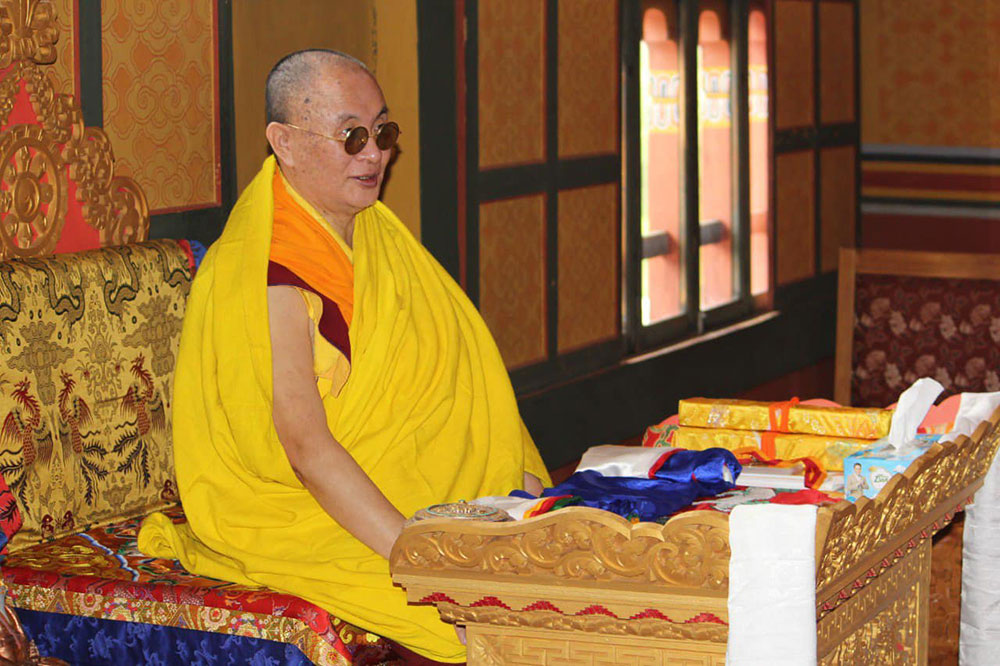The spiritual head of Bhutan made history this week by introducing the Bhikshuni or full female monastic ordination in Bhutan. After many years of discussion and indecision among Tibetan Buddhist leaders regarding the introduction of Bhikshuni ordination in the Himalayan Buddhist world, His Holiness Trulku Jigme Chodrak, the 70th Je Khenpo of Bhutan took the noble and bold step of conducting three days of Bhikshuni ordination for 144 nuns from different Himalayan areas. According to His Holiness’s address at the event, this move came at the behest of His Majesty, the 5th Druk Gyalpo Jigme Khesar Namgyel Wangchuck and the request of Her Majesty, the Queen Mother Gyalyum Tshering Yangdon Wangchuck.
The Bhikshuni or Gelongma ordination, it is widely believed, has never spread in Tibet although the male ordination of a Bhikshu or gelong has been around since the 8th century. An unbroken line of Bhikshuni ordination is said to exist in the Chinese Buddhist tradition and some Himalayan nuns have received full ordination in that tradition but until this week women could receive only the ordination of getshulma or a novice renunciate in Bhutan and the Himalayas.
The Vinaya system or the code of monastic discipline is perhaps the most conservative part of Buddhism with the historical Buddha considered as the only authority to enact Vinaya codes or to change them. The procedures for ordination are rigid and there is a stark difference in the status of the male and female members in the Vinaya, given its deep roots in the culture of the society during the Buddha’s time. Himalayan Buddhist women have so far not been able to even get the Bhikhuni ordination which would still keep them subordinate to the monks. Moreover, suggestions for change have met with much resistance as many believe that the Vinaya system cannot be changed by a figure other than the Buddha or full consensus among all members of the sangha community. Discussion were also happening on the different options for Bhikshuni ordination but no agreement was reached among Tibetan leaders. Thus, the benevolent efforts of His Holiness the Je Khenpo did not go without some dissenting voices.
However, all fears or misgivings have been dispelled by His Holiness in his address. Firstly and most importantly, His Holiness cited the Vinaya scriptures and their learned commentaries which permit the ordination of Bhikshunis by a purely male monastic group where there are no ordained nuns. “As long as it is supported by the Buddha’s Vinaya scriptures, and the rituals are conducted following its intended purpose, there is no need for any further approval,“ His Holiness stated with confidence. Secondly, His Holiness cited many cases of highly respected Tibetan masters who bestowed the full ordination of Bhikshuni on some Tibetan postulants in the past although such lineage did not spread widely. Thirdly, His Holiness pointed out how the main leaders of the Tibetan Buddhist traditions with His Holiness the Dalai Lama at their helm had fully supported the proposal to introduce the Bhikshuni ordination but simply delayed the efforts to actually do it, being bogged down by debates on its appropriateness and procedures.
His Holiness, the Je Khenpo observes that it is no time for endless debates but “for realising opportune priorities of purpose and benefits, and putting them into action”. This he did effectively during this summer Solstice by forming Bhutan’s first community of Bhikshunis. Above all, His Holiness highlighted that he did so out of altruistic intention to benefit the women who approached him for ordination and through a strong and sincere consideration for the creation of female spiritual community, which will serve as a foundation for the Buddhist tradition. Through this act, His Holiness not only leaves behind an outstanding spiritual legacy but opens a new chapter in the history of Buddhism.
Contributed by
Karma Phuntsho (PhD)


